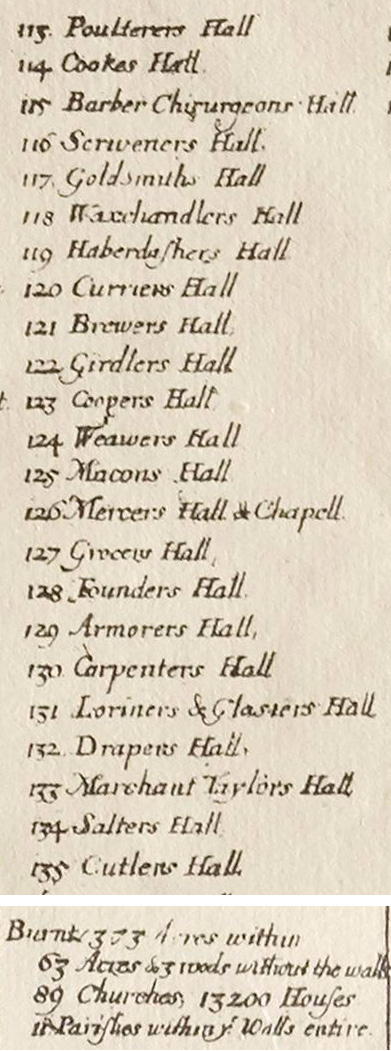
Key to map (ZMAP 4/18)
| Transcript | Glossary |
|---|---|
| 113. Poulterers Hall | People who sold chickens, hens and eggs |
| 114. Cookes Hall | People who prepared and sold cooked food |
| 115. Barber Chirurgeons Hall | People who cut hair and beards and could also carry out operations or remove teeth |
| 116. Scriveners Hall | People who wrote letters and documents for money |
| 117. Goldsmiths Hall | People who worked with gold |
| 118. Waxchandlers Hall | People who made candles and sold them |
| 119. Haberdasher's Hall | People who sold men's clothing |
| 120. Curriers Hall | People who worked with leather (colouring it) |
| 121. Brewers Hall | People who made beer and ale |
| 122. Girdlers Hall | People who made girdles (belts) |
| 123. Coopers Hall | People who made and repaired barrels and casks |
| 124. Weavers Hall | People who made cloth |
| 125. Masons Hall | People who cut stone (for buildings etc) |
| 126. Mercers Hall & Chappell | Important traders who sold rich fabrics like silk and velvet |
| 127. Grocers Hall | People who sold food, like spices and sugar |
| 128. Founders Hall | People who worked with metal |
| 129. Armorers Hall | People who made weapons |
| 130. Carpenters Hal | People who made furniture from wood |
| 131. Loriners & Glasiers Hall | Loriners made metal bits for bridles and saddles (kit for a horse). Glasiers made glass for windows. |
| 132. Drapers Hall | People who sold woollen cloth. |
| 133. Marchant Taylors Hall | People who bought cloth and made it into clothes, usually for men. |
| 134. Salters Hall | People who made and sold salt. |
| 135. Cutlers Hall | People who made, sold or fixed knives. |
| Burnt 373 Acres within | 373 acres were burnt within the city walls. One acre is about the same amount of land as a football pitch |
| 63 Acres & 3 roods without the walls | 63 acres & 3 roods were burnt outside the city walls. A rood is one quarter of an acre. |
| 89 Churches, 132,00 Houses | 89 churches & 132,00 houses were burnt. |
| 11 Parishes within City walls entire. | 11 whole communities within the city walls were burnt. |
4. On the corner of his map, Hollar put some information. It is a list of places that are numbered on the map. This is called a key.
- There are a lot of halls. These were meeting places for different kinds of craftsmen. For example, number 130 is the Carpenter’s Hall. Can you find any more? In pairs, talk about what people had to do in these jobs. (Your teacher will help you with the unusual ones.)
- Try and find some new jobs listed here in the key that were not listed in source 1 (for example: 124. weavers).
- How many houses in the city were destroyed by the fire?
- How many churches were burnt?
